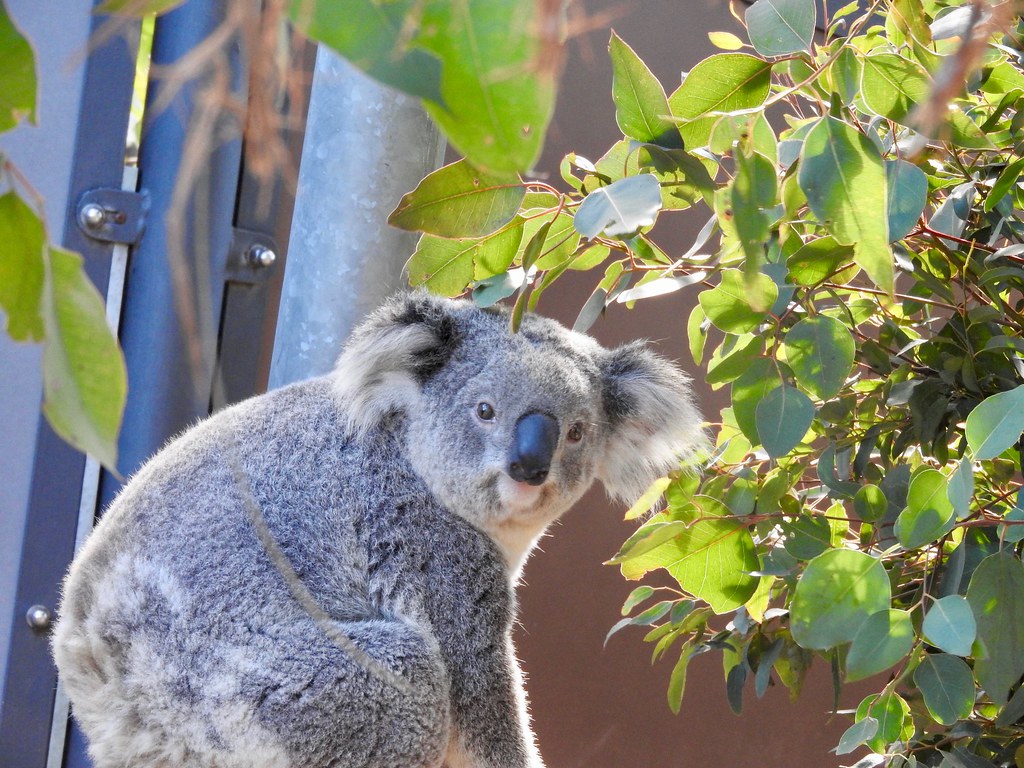The previous article discussed our several encounters with wild animals in their native habitats. However, we saw even more in captivity. My older son collects zoos like I collect breweries. He makes sure that he saves a map from each one as a souvenir too (wonder where he inherited that quirk from?). No matter where we wandered, whether New Zealand and Australia, he focused our attention on the animals.
Kelly Tarlton’s Sea Life Aquarium

First we stopped at Kelly Tarlton’s Sea Life Aquarium in Auckland, New Zealand (map). The most fascinating part to me didn’t even involve the animals. The facility occupied a spit of land adjacent to Auckland Harbour although at a subterranean level below the surrounding area. The entrance and exit popped up above the surface while the car park and a fairly significant road ran above the rest. Windows on one side of the building actually gazed out upon the harbour while traffic passed above, unseen and unheard. Sure, I enjoyed the aquatic creatures although that wasn’t really my thing. An underground aquarium, on the other hand, now that fascinated me.
Many of the exhibits focused on sea life from the waters adjacent to New Zealand and farther south towards Antarctica. This included sharks and stingrays and such. It also included a fairly substantial colony of penguins that waddled atop the ice and swam in frigid waters.
The aquarium was smaller than what we’ve typically experienced in the United States although we enjoyed what was there. It was a nice indoor space to explore during a rainy afternoon.
Otorohanga Kiwi House and Native Bird Park

Last February I put out a call to the Twelve Mile Circle audience for Australasian suggestions. One of the people following the Twitter site said we should visit the Otorohanga Kiwi House and Native Bird Park. That seemed like it could work out because I could combine it with a stop at the Waitomo Glowworm Caves that we already planned to visit. It wouldn’t be out of the way at all. In fact it would be rather convenient.
My kids loved the Kiwi House (map). The facility packed a lot of native birds — not just kiwis — into an easily navigated area. Kiwis are nocturnal so they didn’t run around in an outdoor aviary like most of the other birds. Nobody would see them; they’d be asleep. Instead they lived in a darkened building. Visitors walked into an observation area while the kiwi scurried about on the other side of a pain of glass in an approximation of their normal habitat. We kept quiet, let our eyes adjust to the dark, and eventually we saw the kiwis doing their thing. They were funny little creatures. No wonder they’ve earned a reputation for being cute.
Thanks for the suggestion!
Auckland Zoo

After our inland jaunt and our return to Auckland the local zoo fit perfectly into our plans (map). One wouldn’t expect a nation of four and a half million people to have the facilities of much larger nations although they did a nice job of it at the Auckland Zoo. It focused on animals worldwide, with many of the usual African and Asian species one expects at a typical zoo (e.g., elephants, giraffes, tigers and such). In addition, it placed a lot of emphasis on native New Zealand fauna plus that of nearby Australia to an extent. That interested me more anyway. I could see an elephant anywhere.
For instance, notice the reptile in the photograph above. It looks a lot like a lizard, doesn’t it? That’s incorrect however, it’s actually a tuatara. The order Rhynchocephalia to which tuataras belong split into its own distinct branch of reptiles more than 200 million years ago, and it didn’t include lizards. Only a single species survived to the present day.
Because of that, scientists consider the tuatara particularly important to the study of reptilian evolution. However, habitat pressures have reduced the population to critical levels on just a few offshore islands where it remains. Recent conservation efforts have focused on the eradication of rats on nearby islands so that tuatara can be reintroduced and build the population.
Taronga Zoo Sydney

Once in Australia we focused our attention on Sydney’s well-regarded Taronga Zoo. I enjoyed the ride there almost as much as the zoo itself. The easiest route from downtown Sydney involved a scenic ferry ride across the harbour to the wharf at the base of the zoo (map). From there, disembarking passengers hop onto a gondola for an uphill climb to the zoo entrance. All the while amazing views of Sydney form a scenic backdrop.
Taronga Zoo was massive. It covered as much acreage and included as many species as any of the largest zoos we’ve ever visited. One section focused specifically on Australia so I finally got to see my koala. We paid a little extra for the koala encounter so we could get really close to one (although no touching). She didn’t seem to mind our presence, actually she kind-of ignored us. Normally I’d consider that a bit silly although I figured we might as well take the opportunity because who knows when we’ll get back to Australia?
Articles in the Australasian Adventures Series:
- Preparations and Arrival
- On the Waterfront
- Vistas
- Geothermal
- Heading Inland
- The Hunter Region
- Wild Animal Encounters
- Captive Animal Encounters
- Epic Runs
- Breweries
- Lists
- Changes
See Also: The Complete Photo Album on Flickr

Leave a Reply